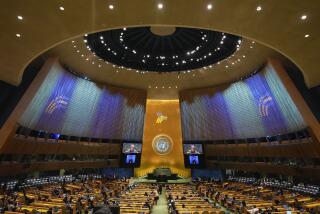Reagan, Soviet Aide OK Modest Nuclear Accord
- Share via
WASHINGTON — The United States and the Soviet Union signed a modest new agreement at a White House ceremony Tuesday to reduce the risk of nuclear war as the two nations began three days of key talks here on arms control, human rights and other issues.
President Reagan and Soviet Foreign Minister Eduard A. Shevardnadze expressed hope that the agreement, which creates “nuclear risk reduction centers” in each capital, would be a prelude to more significant treaties reducing the number of nuclear weapons that might be signed at a future summit meeting.
Shevardnadze delivered a letter from Soviet leader Mikhail S. Gorbachev to Reagan, which he told reporters contains “good things,” though he and U.S. officials refused to provide details. When asked if the letter contained a proposed summit date, Shevardnadze replied: “No date. But a summit is necessary.”
Later in the day, Shevardnadze commented further on the prospects for a summit, saying: “Everything depends on progress in the talks. If there are significant results, there will be a summit. But you don’t want a counterproductive summit, and neither do we.”
There is widespread speculation that a new Reagan-Gorbachev summit conference--their third in as many years--will take place in Washington later this year, probably in November, and that the two leaders will then sign an agreement eliminating all intermediate-range nuclear missiles possessed by the superpowers, those with ranges of 300 to 3,000 miles.
Work on such an agreement is almost completed, although some problems dealing with the pace of reductions and policing of the pact remain to be resolved.
“There is greater understanding” of the problems, Shevardnadze said at the end of the day in which arms control was a major topic of discussion, “but many of the issues remain. Not for nothing will our experts remain behind to talk about it.”
Shevardnadze brought with him “an impressive group” of high-level experts on arms control, Secretary of State George P. Shultz noted, indicating a serious intent to discuss not only issues relating to the intermediate-range missiles but also the other ongoing arms negotiations, on intercontinental-range offensive weapons and on space and defensive weapons.
A working group of experts was set up to seek solutions to the difficulties on the intermediate-range missiles as well as in the other negotiations. The Soviet team was led by veteran negotiator Viktor P. Karpov and the U.S. team by the Administration’s chief arms control adviser, Ambassador Paul H. Nitze.
The group was scheduled to work through the evening and perhaps into the morning hours and report back to Shevardnadze and Shultz this morning before the next meeting of the two men, State Department spokesman Charles Redman said.
In recent days, the two sides each have expressed hope for progress toward their mutually agreed goal of 50% cuts in the intercontinental-range, strategic offensive weapons. On Tuesday, Shultz told reporters that progress might also be expected on nuclear testing and chemical warfare issues.
Shultz described his initial three-hour discussion with Shevardnadze, as well as the Soviet minister’s luncheon meeting with Reagan, as “very straightforward, businesslike and constructive. . . . We’re off to a good start.” Redman said the same words apply to the two-hour afternoon session.
Shevardnadze used similar words--”very constructive, very businesslike”--to characterize the day’s talks.
Shultz also said that he was “rather encouraged” by opening-round discussions about setting up “a more systematic way to make progress” on emigration from the Soviet Union. A second working group of experts will discuss bilateral and human rights issues.
The agreement to set up risk reduction centers in Washington and Moscow, signed Tuesday by Shevardnadze and Shultz as Reagan looked on, is an extension of the U.S.-Soviet hot line that, since 1963, has linked the White House and the Kremlin directly.
As such, Reagan said at the ceremony in the Rose Garden, it is “another practical step in our efforts to reduce the risks of conflict that could otherwise result from accident, miscalculation or misunderstanding.”
The centers, to be manned by Soviet officials in Moscow and U.S. officials in Washington, “provide a means to transmit notifications required under existing confidence-building measures and could play a key role in exchanging the information necessary for effective verification of future arms control agreements,” Reagan added.
In particular, the centers will notify each other, through satellite links, when ballistic missile test flights, large-scale bomber exercises and other military maneuvers are planned. They will also be prepared to exchange information for policing any new arms agreement, such as the dates and locations of on-site inspections to guard against cheating.
Gorbachev and Reagan agreed at their first summit at Geneva in 1985 to allow their experts to study the idea of the centers, which was pushed hard by Sens. Sam Nunn (D-Ga.) and John W. Warner (R-Va.). At their second summit in Iceland last year, they approved negotiations to set up the centers.
More ambitious duties for the centers were first explored, including joint staffing of the facilities in each country by both Soviets and Americans. But this was discarded as impractical because sensitive equipment, such as military communication facilities, would also be present in the centers.
Both Reagan and Shevardnadze expressed the view that Tuesday’s agreement is a stepping stone to bigger things.
The President said he looked forward “to the day when General Secretary Gorbachev and I can sign even more historic agreements in our common search for peace.” He cited the “ongoing and promising efforts” in Geneva to achieve for the first time deep, equitable and effectively verifiable reductions in Soviet and American nuclear arsenals.
Shevardnadze, also striking an upbeat note, said that the risk reduction agreement “is a sign which may be a prelude to more important agreements, in particular, agreements on the reduction of nuclear arsenals.”
More to Read
Sign up for Essential California
The most important California stories and recommendations in your inbox every morning.
You may occasionally receive promotional content from the Los Angeles Times.













